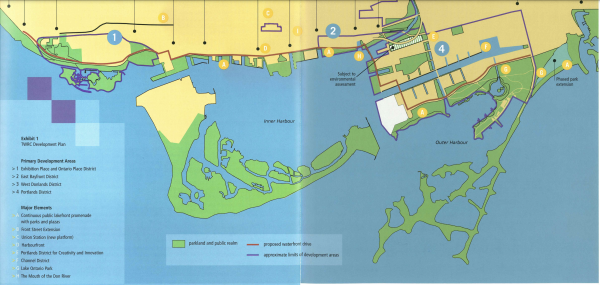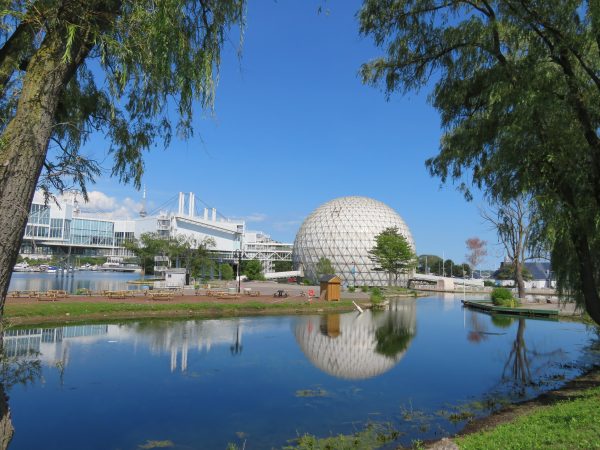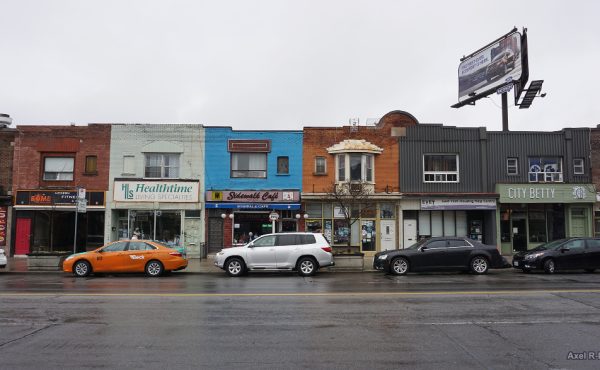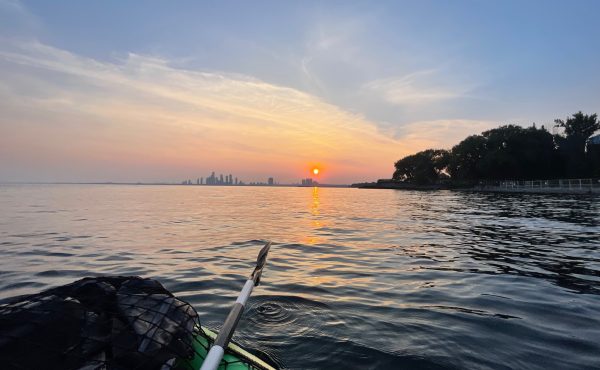
Tomorrow will be an all-day spa event in Toronto.
The day will end with an online “consultation” session at 6pm, showcasing Therme Canada’s mega-spa scheme for Ontario Place. Orchestrated by the company’s Canadian lobbyist, Strategy Corp. (which played a similar role to mark Sidewalk Lab’s arrival here in the fall of 2017), the “consultation” will invariably feature slick videos, idyllic renderings, and testimonials about the apparent urban healing powers of water, wellness, and art.
But the main event scheduled for Wednesday will take place in person, in Waterfront Toronto’s cramped boardroom, and should — if the participants do their jobs in a principled way — feel much more like an intense Swedish massage than a relaxing poolside afternoon.
At about 9 a.m., WT’s design review panel (DRP) will begin its second assessment of the “public space master plan,” which serves as the physical context for Therme’s proposed spa — a $350 million confection of glass and steel that will tower nine-storeys above the water level, require the felling of hundreds of mature trees, and take up most of the available public space on the West Island. The complex will be served by a 2,100-space underground garage, estimated to cost taxpayers about $400 million and located a few hundred metres from the eventual terminus of the Ontario Line.
For the DRP session, the Ontario government, Therme and its lobbyists are rolling out the big guns: Joe Berridge, founder of Urban Strategies, which is overseeing the public space planning, and Don Schmitt, co-founder of Diamond Schmitt Architects, which is the Toronto design firm on the project, will both be speaking.
The DRP is chaired by former chief planner Paul Bedford, who was the principal author of waterfront secondary plan that sought to reconnect Toronto to Lake Ontario. The DRP’s members are a veritable who’s who of the city’s architecture and planning communities.
These people have all known and worked with one another for years or, in some cases, decades. They also have long histories with the waterfront. Berridge is one of the architects of the waterfront revitalization strategy, hatched back in the late 1990s. Schmitt’s late partner Jack Diamond pushed an inspired but sadly unrealized redevelopment vision for the Parliament Street slip; a decade later, their firm designed what was the very first commercial project on the East Bayfront, the Corus head office, and showed the city how a forlorn brownfield site could be transformed into a landmark waterfront destination complete with jobs and public space.
It’s important to pause here and consider Waterfront Toronto’s positionality in this discussion. When the DRP had its first go at Therme’s heavily lobbied plan last summer, the members were told in no uncertain terms to avoid opining on the merits of the spa, and focus instead on the half-completed open-space plan commissioned by Infrastructure Ontario and drawn up by Urban Strategies. The DRP’s job, in other words, was not to pass judgment on whether it was a good idea to allow the government to privatize a large chunk of Ontario Place.
The people involved on both sides of this mega-project know how power is exercised in this city. They’ve worked in and around both corporate and political power for their entire careers — sometimes in its service and other times as advocates for reform.
Lest we forget, Waterfront Toronto was created to cut through some of the most entrenched and least productive reservoirs of power — those wielded by the multiple public sector bureaucracies bickering with one another and working at cross purposes on various waterfront projects. Waterfront Toronto’s earliest proponents, Berridge and Bedford among them, argued that a single development agency, with accountability only to the three orders of government, was necessary to advance an expansive vision of the waterfront that served the public interest by ensuring accessibility and high-quality open space as a frame for future development.
Waterfront Toronto’s mandate included Ontario Place. As the agency’s public documents stretching from its inception in 2002 to the present day attest, the agency’s “designated” geographical scope includes Ontario Place as well as the Canadian National Exhibition grounds. Waterfront Toronto, in short, has a responsibility to assert its views on the appropriateness of this scheme viz the greater good of the Toronto waterfront as a unified public space.

Waterfront Toronto’s role, of course, is complicated because it has three shareholders with assets on the waterfront and whose interpretation of the public good can diverge greatly. But in the past twelve years, the agency has been able to promote and defend its mandate to build a great waterfront in the face of intense political headwinds.
During Rob Ford’s term as mayor, brother Doug, then a councillor and now the premier, sought to subvert Waterfront Toronto’s planning for the Port Lands. But the agency was able to marshal and channel public support to block his short-sighted gambit. Waterfront Toronto has also worked closely with both the federal and provincial governments on large scale projects such as housing for the PanAm Games. And it succeeded in securing $1.25 billion in funding to re-build the mouth of the Don.
Of course, during the Sidewalk Lab debacle (2017–2020), Waterfront Toronto lost its way and almost ceded a vast chunk of the eastern waterfront to Alphabet/Google’s smart cities subsidiary, which had friends in the highest of places. In the end, however, Waterfront Toronto’s board, led by Steve Diamond, mustered the wherewithal to let Sidewalk know, in no uncertain terms, that it had to stay in its lane if it wanted to do business in Toronto. The company couldn’t abide by those terms and pulled the plug.
We’ve reached a moment when Waterfront Toronto’s DRP and its board must reflect on the importance of these pivotal moments in its 25-year history, and then consider how these decisions inform the task at hand with Therme.
The Austrian company’s proposal fails on every measure — it’s the wrong project, in the wrong place, at the wrong time. We don’t know where the money is coming from. We don’t know what happens if the spa business fails. The proposal makes a mockery of the public space principles that have guided waterfront revitalization for a quarter of a century. And I would be willing to wager a large bet that everyone involved, including the proponent’s consultants, know it.
Perhaps the Ford government is going to muscle this scheme through council and across the goal line. But let that decision be a political one exclusively. Waterfront Toronto knows what its mandate is, and knows — or should know — why a private human aquarium that turns its back on the city has no place on one of the most prominent public spaces in Toronto.
It’s time for Waterfront Toronto to speak truth to power (and capital), as, indeed, it has done at critical junctures in the past. Anything less will be an abdication of its mandate.
photo by Sean Marshall





7 comments
Thank you so much for your advocacy.
Wonderful article. What’s missing is a discussion of the City-owned land at Ontario Place, that the City wants to give to the Province to give to Therme. Presently Ontario Place is or acts as if it is private property, with OPolice (security guards from the company “Neptune” which acts as if it were the God of “NO SWIMMING”) acting as if they own the place. When we clean up the beach the security guards tell us that we’re not allowed to pick up other people’s garbage, and they call the police on us. One nice thing about the City-owned land is that it is outside this privatization and “PRIVATE PROPERTY” of Ontario Place Corporation.
So let’s keep it that way. Let’s keep some of Ontario Place public, like the WestWall where we often swim when they try to block us from accessing the beach.
Check out some of these beautiful pictures from the parts of Ontario Place that are still public (City-owned):
https://photos.app.goo.gl/nF9Ua8Lvk8Y8KYs6A
That’s gonna leave a mark. I hope.
Some parts of their plan indicate that the public spaces might actually get improved. If the beach becomes swimmable again, and the trails are used and populated with people, I don’t care where the money is coming from. Also, I think a spa here will drive more visitors and tourists from outside Toronto which is good for a city that has been rapidly emptying for the last two years.
The city might appear to have been “rapidly emptying for the last two years”. No mystery why.
I very much doubt that it needs a spa “drive more visitors and tourists”. If they aren’t interested in coming back now, why would a spa entice them? If they are interested in coming back, they why do we need a spa?
Instead of spending money on much needed Health Care, or Schools and Education we are supposed to think this monstrosity will be great. It is a gangster’s view of what a province needs.
PA, really? “Toronto emptying” lol! You smoking what the Fords’ smoking. Your comment reeks of trashy Therme insider and you state no supporting data to your emptying opinions. Downtown Toronto grew over 15% from 2016 to 2021, the city plans to grow a further 30% by 2030. PA, let me correct your statement, the last thing we need is a tacky private spa to ruin one of the few precious green spaces left in our rapidly densifying city that is already suffocating from people swarming in for events.